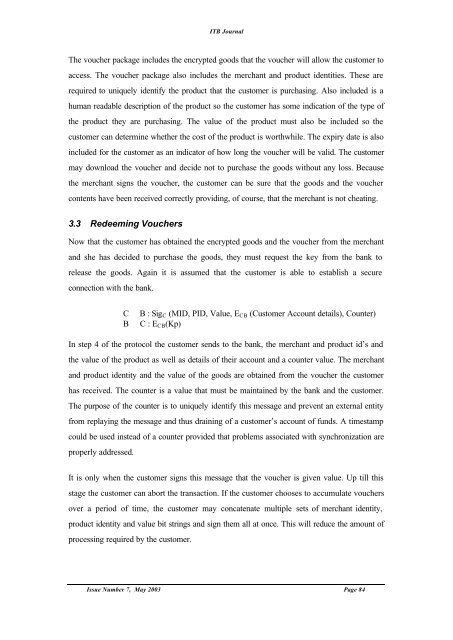ITB Journal-May-2003 - Institute of Technology Blanchardstown
ITB Journal-May-2003 - Institute of Technology Blanchardstown
ITB Journal-May-2003 - Institute of Technology Blanchardstown
Create successful ePaper yourself
Turn your PDF publications into a flip-book with our unique Google optimized e-Paper software.
<strong>ITB</strong> <strong>Journal</strong><br />
The voucher package includes the encrypted goods that the voucher will allow the customer to<br />
access. The voucher package also includes the merchant and product identities. These are<br />
required to uniquely identify the product that the customer is purchasing. Also included is a<br />
human readable description <strong>of</strong> the product so the customer has some indication <strong>of</strong> the type <strong>of</strong><br />
the product they are purchasing. The value <strong>of</strong> the product must also be included so the<br />
customer can determine whether the cost <strong>of</strong> the product is worthwhile. The expiry date is also<br />
included for the customer as an indicator <strong>of</strong> how long the voucher will be valid. The customer<br />
may download the voucher and decide not to purchase the goods without any loss. Because<br />
the merchant signs the voucher, the customer can be sure that the goods and the voucher<br />
contents have been received correctly providing, <strong>of</strong> course, that the merchant is not cheating.<br />
3.3 Redeeming Vouchers<br />
Now that the customer has obtained the encrypted goods and the voucher from the merchant<br />
and she has decided to purchase the goods, they must request the key from the bank to<br />
release the goods. Again it is assumed that the customer is able to establish a secure<br />
connection with the bank.<br />
C B : Sig C (MID, PID, Value, E CB (Customer Account details), Counter)<br />
B C : E CB (Kp)<br />
In step 4 <strong>of</strong> the protocol the customer sends to the bank, the merchant and product id’s and<br />
the value <strong>of</strong> the product as well as details <strong>of</strong> their account and a counter value. The merchant<br />
and product identity and the value <strong>of</strong> the goods are obtained from the voucher the customer<br />
has received. The counter is a value that must be maintained by the bank and the customer.<br />
The purpose <strong>of</strong> the counter is to uniquely identify this message and prevent an external entity<br />
from replaying the message and thus draining <strong>of</strong> a customer’s account <strong>of</strong> funds. A timestamp<br />
could be used instead <strong>of</strong> a counter provided that problems associated with synchronization are<br />
properly addressed.<br />
It is only when the customer signs this message that the voucher is given value. Up till this<br />
stage the customer can abort the transaction. If the customer chooses to accumulate vouchers<br />
over a period <strong>of</strong> time, the customer may concatenate multiple sets <strong>of</strong> merchant identity,<br />
product identity and value bit strings and sign them all at once. This will reduce the amount <strong>of</strong><br />
processing required by the customer.<br />
Issue Number 7, <strong>May</strong> <strong>2003</strong> Page 84
















